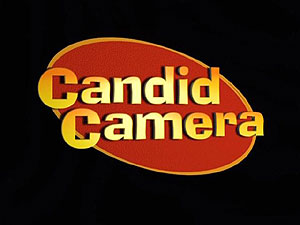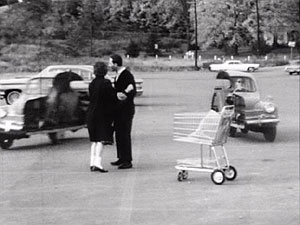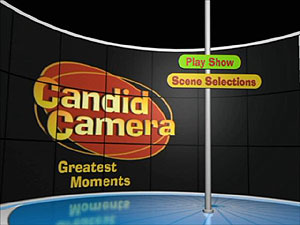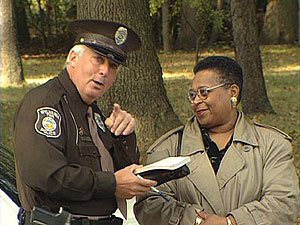| Reviews & Columns |
|
Reviews DVD TV on DVD Blu-ray 4K UHD International DVDs In Theaters Reviews by Studio Video Games Features Collector Series DVDs Easter Egg Database Interviews DVD Talk Radio Feature Articles Columns Anime Talk DVD Savant Horror DVDs The M.O.D. Squad Art House HD Talk Silent DVD
|
DVD Talk Forum |
|
|
| Resources |
|
DVD Price Search Customer Service #'s RCE Info Links |
|
Columns
|
|
|
Candid Camera - 5 Decades of Smiles
A massive box set of the reality TV pioneer
The Story So Far...
Previously, collections of segments were available on DVD directly from "Candid Camera," but not full episodes. "The Funt Family Collection" combines two specials: "'Candid Camera''s Biggest Surprises" and "'Candid Camera''s Pets & Animals," while "Most Requested Characters" focuses on the most recent incarnation of the series, with hosts Peter Funt and Dina Eastwood.
 |
"Five Decades Of Smiles: The 'Candid Camera' Deluxe Boxed Set," a 10-DVD collection, arrives in a cardboard slipcase. The collection covers five decades of the series, and includes a newly-created retrospective, "The Best of 'Candid Camera.'" In all, there are 44 full-length episodes, including series episodes and specials, plus bonus materials, which adds up to approximately 24 hours of hidden-camera comedy.
These are not season collections, but selected episodes. Some of the years that the show was on the air, it aired weekly, while some later years saw the frequency reduced to occasional specials. As a result, some of the decades get more representation than others. The episodes found on the two-volume decades are not in chronological order across the two discs.
Every disc comes packaged in a one-tray digipak case, with the exception of the Greatest Moment discs, which come in a two-tray digipak case. The cases have an episode list, and segment listings for each episode. There are no audio options or subtitle options, and no closed captioning.
Per "Candid Camera"'s Web site, these discs are also available in individual volumes, which makes sense, as each case has a UPC bar code.
The 1960s
The Show
The episodes from the '60s reflect a world that was much different than today, as the gags show the thoughts and opinions of the times. Bits that star Fannie Flagg as the first woman pilot and which show men standing around holding a purse for a woman who has disappeared, show the thoughts about gender identity. Even women were nervous about the idea of having a woman flying their plane.
Many of the sketches are attempts to see how far people's politeness can be stretched. One bit, which sees strangers hijack a person's umbrella is stunning when one considers how it would play out today, while another, which has a kissing newlywed couple blocking the way through a hallway, would likely last about a fraction as long, as patience would be scarce (a fact proven on the '90s DVD.) Because of the change in behavior among the general populace, it's somewhat hard to relate to these bits, but as an oddity, they are worth a look.
While this set includes two of the show's landmark innovations, one in which a woman "drives" a car without a motor into a service station and one where a car can split in two, and a historically important episode that takes place in the Soviet Union, many of the gags are just uninteresting. Watching a cat chase electric race cars or a woman watching a wrestling match can be cute, but it doesn't offer that key pay-off: the reveal. The same problem goes for the many bits with children, to whom the reveal means next to nothing, so the segments fall entirely on the cute side of the meter.
The DVDs
The '60s episode selections are offered in two volumes on two DVDs. Each disc features six episodes. The main menu opens with a bit of animation, before listing the episodes and bonus features, along with a play-all feature. Select as episode number and a chapter selection menu is displayed, where you can choose to watch the whole episode or a specific segment. The menus are a bit dull in terms of the color but are very functional, with the exception of the theme song sting between each screen of the episode selection menus.
The Quality
The black and white full-frame episodes are decent, with a mix of quality. In-studio host segments are surprising clean, with just film grain and some ghosting preventing them from being pristine, as the detail and clarity is great. On-the-scene footage is darker, naturally, and full of dirt and damage. It's not the kind that will distract from viewing. When the show switches to full-frame color, the look is classic TV color, with bland hues and a generally soft look, though blacks are nice and deep. The sound is flat, like the soundtracks of most shows of this age, with a mono mix.
The Extras
The first volume features an introduction by Peter Funt that covers the show's history in the 1960s. Running about nine and a half minutes, the intro discusses the show in the context of the time, illustrates the most memorable segments and takes a look at the show in general, including the hosts. It's not an entirely sanitary history, as there is some mention of tension on the set, but it's obviously a glowing look back, as it's created by Funt and the show's staff. Funt isn't the most energetic narrator, but he does what's necessary.
There's also two collections of "Funt Favorites," which runs 19 minutes on Vol. 1 and 24 minutes on Vol. 2. One would assume these were chosen by either Peter Funt or his family. These segments are selected from the episode on each disc, and is essentially the best of each platter, played via seamless branching.
 The 1970s
The 1970s
The Show
If Allen Funt thought kids were good for gags in the '60s, he fell in love with the concept in the '70s. Almost every episode in this collection features a segment with kids, while several have multiple bits with kids. Once again, they are more cute than they are funny.
On the other end of the spectrum, the influence of Funt's film What Do You Say to a Naked Lady? was seen in sketches where people's clothes break away, or one where men's medical exams are performed by a woman. Only a few such gags are included on these discs, but there's more of a cheeky feel to this decade's episodes, especially in comparison to the later PAX network episodes.
The concept of aggravating people isn't as prevalent in this decade as it was in the '60s, with bits that puzzle people becoming the norm. Dogs that change size, statues that come to life and a restaurant that empties on cue are some of the bits that really worked, as watching people work things out in their heads was sometimes funnier than the reveal. There is one "how much more can he take" bit here that's fascinating, and that's a very violent bit from a Japanese version of the show. Embarrassingly (at least now) it leads to the hosts trying a Japanese accent, but the segment is highly unusual.
There's only a few episodes on Disc One because of the presence of the show's 25th Anniversary special, which was actually the first episode of the decade. At almost 50 minutes, the special is twice as long as a regular episode, and attempts to get in most of the show's biggest hits, including the talking mailbox, a young girl playing Cinderella with Allen Funt, and even a censored scene from What Do You Say to a Naked Lady?, which is hard to imagine for network television. Allen Funt is joined on-stage by former show regulars as they set-up the bits. For some reason, the show's creators could never be as funny when hosting as the segments were.
The DVDs
The '70s episodes are also offered in two volumes on two DVDs. Vol. 1 has four episodes and the series' 25th Anniversary special, while Vol. 2 has six episodes. The menus follow the same style as the '60s discs.
The Quality
There's plenty of noise in these full-frame episodes, along with grain, dirt and damage during the gags. The in-studio segues have some vibrant color, and the general quality of an old episode of "Match Game" or perhaps a local '70s TV news broadcast, with softness, pixilation and a very light level of detail. The most obvious sign of age is the green-screen effect that looks awfully low-budget. The audio is straight-up '70s TV audio, without speaker activity, but a well-recorded track that keeps the dialogue clean.
The Extras
Peter Funt returns on the first volume for an introduction that focuses on the '70s version of the show. Checking in at around seven minutes, the intro looks at the world around the show, the fashion of the series and the changing world of hidden-camera comedy, as well as once again pointing out the most memorable segments. The series went through a lot of change in this decade, including location and hosts, and this featurette is a nice overview of it.
There are also two more collections of "Funt Favorites," which run for 23 minutes on Vol. 1 and 18 minutes on Vol. 2.
The 1980s
The Show
"Candid Camera" didn't exist as a weekly series in the '80s, instead enjoying a revival as a series of themed specials, starting with the show's 40th Anniversary show. Set-ups for the classic episodes are done by a variety of big-name (for the time) celebrities, including George Burns, Kristy McNichol, Emmanuel Lewis, Dr. Ruth, Danny Thomas and Paul Newman. The bits are grouped by theme, including jokes built around phones, kids and music, along with the best of show regular Fannie Flagg, and a look at the practical applications of the show's concept. It's a decent look back, but as one of several in this collection, it repeats segments seen elsewhere in the set. One the plus side, it is a best-of, with few dead spots, with the exception of the promos for the show's good works.
The four 30-minute specials included are about doctors, kids, money and sports. The doctor episode, co-hosted by Peter Funt and "SNL" alum Victoria Jackson, has some funny bits, including one in which a patient is mistaken for a doctor by a patient who takes off her clothes for an ear exam. The reactions of the mistaken patients run the gamut of human nature, making for some funny and true moments.
"Candid Kids," co-hosted by Allen Hunt and Nancy McKeon ("Facts of Life"), was an attempt at a kid-focused spin-off, but it didn't work. The show was a mix of re-made old gags, classic footage and new bits, but it remained cute, instead of funny. "Funny Money" is the least funny of the four, without much to recommend about it, while "The Sporting Life" is just a slice above it, thanks to a ridiculous gag that takes place during an actual minor-league baseball game, involving the pitcher.
The DVD
"The Best of the 1980s" in just one volume, including four specials, and the series' 40th Anniversary special. The menus still remain the same consistent style, listing the two special features.
The Quality
Anyone who has watched an "SNL" rerun from the '80s will recognize this level of quality. While scenes like the pie fight look great, other scenes suffer from softness. The full-frame in-studio footage has a video harshness to it, with some pixilation on edges and vieo noise, while colors and detail are pretty good. The audio is standard TV Dolby Digital 2.0, with a few hiccups along the way, resulting in distant, tinny audio.
The Extras
Peter Funt introduces the 1980s in a featurette that's just under five minutes long. Among the topics Funt talks about are the political and social landscape of the decade, a new adult version of the series and new life for the series in a range of media and purposes. It seems like there's less to say about each successive decade, as these intros get shorter and shorter.
14 minutes of "Funt Favorites" from these '80s special are included as well.
 The 1990s
The 1990s
The Show
This collection looks to be the shortest, with just three episodes, but at 141 minutes it's the longest of the one-disc sets.
"'Candid Camera' Looks at Love" does exactly what the title says, with a boat load of bits, including some "Then & Now" segments that compare old gags with new recreations. A couple of guest stars, including Yasmine Bleeth and soap opera actors Kristian Alfonso and Shemar Moore, help pull off some of the segments, but the better bits are the ones where the "victims" are the only stars, including one with a machine that marries people automatically.
"'Candid Camera' Across America" features location specific jokes, including gags about renaming Nebraska, closing Texas and Susan Anton buying a town in Oregon. One of the most ridiculous bits features people convinced they will be able to see Abraham Lincoln in a rock formation, if they bend over and look through their legs. It's amazing how gullible people really are.
One of the things you rarely see during this series is the preparation that goes into a gag. But during a bit based around the Windy City of Chicago, the production process is shown, and it's really a nice touch, especially when the segment goes as well as it goes.
The final special on this disc is "'Candid Camera''s Battle of the Sexes," which introduced Suzanne Somers as the host of the show. The subject of plenty of jokes in earlier decades, gender identity is the core of every gag here.
The DVDs
Three network specials make up the one-disc "The Best of the 1990s." The menus are the same as the other volumes, and hold access to the two special features.
The Quality
Outside full-frame footage varies based on the sunshine in the scene, but for the most part its decent, with some pixilation and a good level of detail Indoor footage looks good during gags, but the video shot on the set with the hosts is mixed. When Lorianne Crook is the host, it's solid, colorful, and defined, but when Somers takes over, it is blurry and soft, with plenty of shimmering. As this was only evident during Somers' reign, one has to think this was an effort similar to the old Vaseline on the lens trick to hide wrinkles. The audio is standard 2-channel stereo, delivering a pretty average TV mix.
The Extras
Peter Funt's intro is a bit longer, at just over six minutes, and more interesting, as the '90s saw the death of Allen Funt and more challenges for the series. This intro points out that there are aspects of the series that are not reflected in this collection, including the missing 50th Anniversary special, and any episodes from the misbegotten syndicated "Candid Camera" series, starring Dom DeLuise. Once again, Funt should be praised for not entirely glossing over the tough times.
27 minutes of "Funt Favorites" from the three specials are also included.
Today
The Show
The most recent incarnation of the show, which recently ended, aired on CBS and then PAX. This version of the show was much tamer than earlier series, without much in terms of edgy material, edging more toward family-friendly ideas like having Ray Romano blow the candles out on a toppling birthday cake, a restaurant table that raises as people eat or a big Bingo winner in a fixed game.
The safe concept seemed to carry over to the banter between hosts Peter Funt and Suzanne Somers was bland and unfunny, but looking back, this was often the case in the series. The ham-handed writing for the hosts would make the award-show writers jealous.
Despite such concept limitations, the series managed to come up with some great ideas, including the sideways elevator, an incredibly complex gag that works brilliantly, and the disappearing building, which is another feat of joke engineering. This run probably has the best laugh to dud ratio of all the decades, which may say something for going in a silly direction rather than a controversial one.
The DVDs
"The Best of Today" is a two-volume collection, presented on two DVDs. Both discs have six episodes each.
The Quality
The blur and softness is toned down a bit in Somers' full-frame episodes, though the shimmering, especially around Funt's collar, is still pretty bad. Interior gags look great, with excellent color and detail, while outdoor scenes show the weakness of working without the complete control of a "studio" setting, as the scenes can look washed out. Audio remains without complaints.
The Extras
Peter Funt's introduction to the most recent version of "Candid Camera" talks about a new style in the series, which involved including more reveals. New hosts Suzanne Sommers and Dina Eastwood, the series' prejudice project, and a look at the future make up what is a somewhat somber piece, as it feels like time has passed "Candid Camera" by. Of course, looking at the previous volumes, it seems like this was a statement made several times before.
Disc One has 20 minutes of "Funt Favorites," while Disc Two has 18 more.
Greatest Moments
The Show
This newly-created collection of the series' best moments had the odds stacked against it, as the previous eight DVDs supposedly include the best of the '60s, '70s, '80s, '90s, and '00s. In other words, what's left and what won't be repeated from the other discs? Well, there's absolutely a large amount of repetition, and just a few interesting new bits, like the "Then and Now" bits carried over from the '90s specials, which compare old gags with their remakes, proving that human nature doesn't change much.
After watching the first eight discs, and then this one, it feels like this was put together to offer as a lower-cost alternative to the 10-disc set, as one isn't likely to need it if you own the rest of the discs, though the extra might serve as an incentive to go for the gusto. In truth, this set might actually be better than the other discs, as it's only the best, with none of the chaff.
The DVDs
"The Best of 'Candid Camera'" is made up of two DVDs, with the main feature on Disc One and the bonus feature on Disc Two. The menu is simpler this time around, with just the play-all option and a scene selection menu. The "Best Of" is broken down into 12 "theme" chapters, with several segments from that theme in each chapter.
The Quality
Take the other ratings, mix them up and serve with a sprig of mint. There's a wide spread of sources in this one, and consistency is not really a word you could use to describe it. Nothing looks or sounds worse than it did on the other did on the other discs though. The extra looks a little worse for wear though, but that's to be expected, considering the age.
The Extras
Disc Two has the only extra in this volume, which is the first "Candid Camera" episode from 1949. It's not the first ever episode of this show, but the first to bear this name. It is not very entertaining, as the majority of the bits get their kick from the novelty of the concept, but as a historical document, it's pretty interesting.
 The Bottom Line
The Bottom Line
This is an astounding collection, and really the only way to properly represent a series like "Candid Camera," which has been on the air for over 50 years, in various forms and with various personalities involved. Unfortunately, it may be a bit too much "Candid Camera," as less than halfway through the set I began to lose interest (though I doubt you'll be watching them under a deadline. Spreading out the 24 hours is probably a good idea.) Even so, with just 44 episodes from 50 years, and with the compilation shows repeating segments several times, it's hardly the complete version of the show that DVD collectors now expect.
As a pioneer in the field, the show broke new ground again and again, and this collection does an excellent job of showing just how it did it. Some of the early discs are dated and less entertaining than the more recent episodes, but overall, there are laughs to be had from episodes across the set. A few more extras, or more to the point, more varied extras, would have been appreciated, but there's plenty to watch here either way. Fans of the series should feel safe about plunking down the serious money this set will cost, while the curious might want to own the decade that speaks closest to their hart or the Greatest Moments set. Just beware that the second volume of any decade has slightly less content than the first volume, as there's no introduction.
Francis Rizzo III is a native Long Islander, where he works in academia. In his spare time, he enjoys watching hockey, writing and spending time with his wife, daughter and puppy.Follow him on Twitter
*The Reviewer's Bias section is an attempt to help readers use the review to its best effect. By knowing where the reviewer's biases lie on the film's subject matter, one can read the review with the right mindset.
|
| Popular Reviews |
| Sponsored Links |
|
|
| Sponsored Links |
|
|
| Release List | Reviews | Shop | Newsletter | Forum | DVD Giveaways | Blu-Ray | Advertise |
|
Copyright 2024 DVDTalk.com All Rights Reserved. Legal Info, Privacy Policy, Terms of Use,
Manage Preferences,
Your Privacy Choices | |||||||














